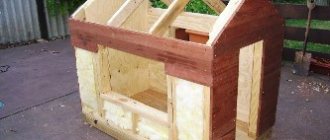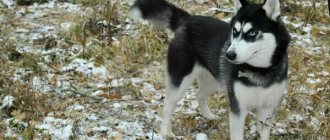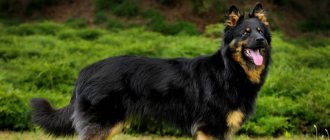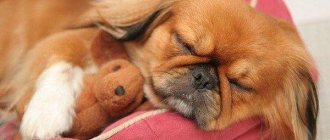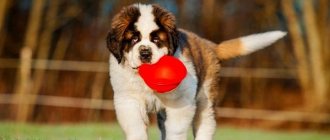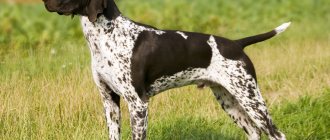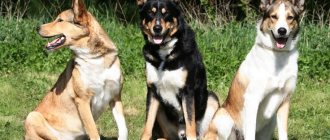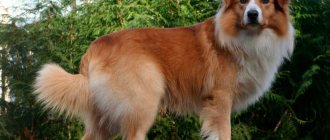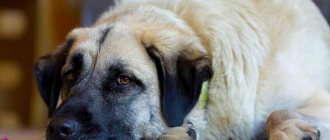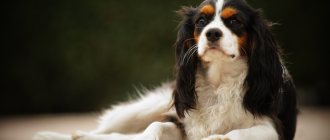Description and character
- Country: Germany.
- Type: companion dog.
- Weight: for males - from 9 to 10 kg, for females - 8-9 kg.
- Height: a male of this breed can reach 40 cm, and a female can reach from 28 to 36 cm.
- Life expectancy: with proper maintenance - from 13 to 15 years.
- Color: black with brown spots.
- Types: smooth-haired and wire-haired.
- Description of the Jagdterrier breed: This hunting breed is not distinguished by the sophistication or grandeur that is inherent in other similar dogs, but Jagdterriers attract attention with their laconic form and style. Thanks to their heavy chin, intense gaze and the inherent composure of this breed, German hunting terriers create the impression of strict and tough dogs even when calm and freely standing. A dark, non-staining color, dense coat that does not collect dirt and does not freeze snow, and a good undercoat, which allows the dog to easily withstand the cold - everything corresponds to the main purpose of the breed. German Hunting Terriers have instant reactions, strong, well-developed jaws with strong teeth for a secure grip.
- Temperament: This breed has a complex temperament, which, if mastered, is well suited for hunting purposes. Such dogs are stubborn, brave, fearless, intelligent and very vigilant. They are active and full of energy even in old age. Jagdterriers tolerate long roads well. However, the characteristics of the Jagdterrier breed are not limited to their hunting qualities. Living in a family, they can be affectionate and playful, to say nothing of their devotion and loyalty to their owners. Dogs of this breed can be not only excellent hunters, but also reliable guards. But in order for the dog to fulfill the tasks assigned to it and meet all the owner’s expectations, it must be treated with respect and time spent on training.
Character and standards
The breeders developed an exclusively working breed. Dogs of this breed have an amazing sense of smell, excellent reaction and absolute endurance. They are hyperactive and will not sit still. Even in infancy, Jagdterrier puppies perfectly perceive commands.
Jagdterriers easily tolerate changing places, have good health, but at the same time have a rather complex character. That is, this breed is not recommended for novice dog breeders. The owner must be experienced, strict and persistent - this is the only way to raise a “stubborn little one”. But with all this, yags also need love.
As for friendship with other animals , this is rare for the yagda. Although if, for example, another pet appeared earlier than the Jagdterrier puppy or together with it, then, usually, they become friendly. It is better not to let him near other people's animals (whether cats, dogs or birds).
You should also be careful with children. A dog does not always perceive a human child as a person. It can often be perceived as unidentified game, which the owner does not allow to touch.
But at the same time, with proper upbringing, yagdas are infinitely loyal to their owner. They are excellent watchdogs and will protect their owners to the end. But they do not favor strangers and can be quite aggressive. But again, education decides everything.
Standards
The Jagdterrier is a small dog that has an excellent physique and strong muscles. It must be said that the difference between a male and a female is immediately visible. Males have a stronger constitution, but females have a smaller and more graceful constitution.
The height of dogs of the Jagd Terrier breed reaches 40 cm, and their weight is up to 10 kg (females - up to 8.5 kg). Regarding external standards, they are as follows:
- The head is wedge-shaped with prominent cheekbones and flat cheeks. The transition from forehead to muzzle (stop) is smooth.
- The teeth are large, complete and have a strict, correct bite.
- The nose is medium, not forked, mobile, the nostrils stand out.
- The eyes are small, oval, deep-set and always dark in color.
- The ears are triangular in shape, set high and slightly raised.
- The neck is of medium length with a pronounced scruff, smoothly blending into the dog’s shoulders.
- The body of the yagda is strong and slightly elongated. The back is not wide, but very strong. The back line is straight. The chest is well developed and muscular. The croup is strong and long. The stomach is tucked up, one might say “athletic”.
- The limbs are parallel, straight and strong. And the paws are small, oval and have tightly clenched toes.
- The tail is set high, slightly thick and docked at 1/3 of its entire length.
- The skin is quite dense, there are no folds on it and it matches the color of the dog’s fur.
Dog color:
- The main color is black, brown or gray-black.
- Tan marks are red or light brown. They are found on the face (mask) of the animal, on the eyebrows, neck, paws and under the tail.
- White spots are allowed only on the chest and fingers. Everything else is considered a marriage.
History of the breed
Developed in Germany at the beginning of the 20th century, this breed is the result of crossing fox terriers, small German hounds, dachshunds and pinschers. The purpose of such crossing is to obtain a dark-colored dog that will adapt well to any conditions, withstand heavy loads and be ideal for hunting.
Jagdterriers have always been very popular in their homeland and in Austria. In the CIS countries, this breed appeared at the end of the twentieth century.
Did you know? Trying to achieve a dark color for the breed, breeders have ruthlessly culled many animals, since it is believed that
light-colored “helpers” bring bad luck when hunting and can scare away prey.
Selection and price of a puppy
German Hunting Terrier puppies should be very similar to their parents, therefore, when choosing a dog, you should definitely look at its parents. It is important to learn about the dog’s working qualities, psyche, and health. It is also necessary to ask in what conditions the puppy lived. If the purpose of the acquisition is to get a good hunter, it is advisable to choose from repeated participants and winners of exhibitions. The puppy must be well-fed, active, and energetic.
If a Jagdterrier who is less than a year old looks thin, this may be a sign that he has worms. A skinny pet may grow up with abnormal bone alignment, which will be difficult to correct and return to good condition.
Terriers are a group of dog breeds designed for hunting. In the modern classification there are about 30 breeds. Familiarize yourself with the nuances of keeping a Yorkshire Terrier, Jack Russell Terrier, Staffordshire Terrier, Russian Toy Terrier, Bull Terrier, Pit Bull Terrier.
A puppy that actively moves and escapes from the hands, tries to wriggle out and attack while playing, will be a good helper in the hunt. Quieter dogs often bring more trouble to their future owners. The price of Jagd Terrier puppies can vary from $50 to $150 , depending on age, parents, documents, vaccinations.
Training a Jagd Terrier puppy in
When you turn to our dog training center for help in training a Jagd Terrier puppy, you can be sure that a real specialist in his field
and will provide training at the proper, highest level.
- A dog trainer will come to your
home at a time convenient for you. - Classes are held 1-2 times a week
, depending on the program. - Instructors work from 9:00 to 21:00
, on weekends inclusive - The training program is drawn up at the first lesson,
taking into account the breed, age, personal characteristics of the dog and your wishes for training - Some classes take place at home
, some
outside
, depending on the topic of the lesson. - Puppy age
from 2 months
Our Center employs dog handlers - animal psychologists who have experience in working with Jagd Terrier puppies and training adult dogs from 10 to 35 years old, who know all the nuances of their behavior
and features of training at each stage of a dog’s growth. Therefore, your pet is guaranteed to learn to carry out your commands the first time in any conditions, and will become your faithful and reliable companion.
Is it possible to keep the breed in an apartment?
The size of the Jagdterrier allows it to be kept in an apartment, but it is worth remembering that this breed is intended primarily for hunting. Therefore, when getting such a dog in an apartment, you need to be prepared for many difficulties. Firstly, German hunting terriers are attached to one owner. It is necessary to raise the puppy well so that he gets along with all family members, is kind and playful.
Secondly, Jagdterrier dogs need constant physical activity: if the dog does not hunt, it is necessary to run with it regularly. Thirdly, it is worth considering that this breed is aggressive towards other animals. This instinct is inherent in it by nature and it is quite difficult to overcome it, so it is not advisable for the Jagd Terrier to live in the same apartment with cats, parrots, other dogs, etc.
At what age do you start training?
Puppy training must begin from the very first days
the presence of a dog in your home. Because already from infancy, the puppy must learn the rules of behavior in your house, what is allowed and what is forbidden, how to behave with all family members, even the smallest and oldest, what he can play with and what he can’t, where to go. toilet and much more.
And we are talking, first of all, about the proper upbringing of a Jagd Terrier puppy, and you can start training and learning commands when the puppy is completely comfortable in your home. As a rule, one week is enough. By this time, the puppy is already filled with curiosity and is diligently exploring the world around him. If, after this time, the puppy remains fearful and does not make contact well, then it is better to seek help from a dog handler-animal psychologist, because This behavior is not typical for puppies of this breed.
When can you start training with a dog handler?
The beginning of the puppy's training coincides with the time of the first exit to the street. When the first two vaccinations have already been done, the quarantine (lasts 7-14 days, depending on the vaccination) after them is over. It is not at all necessary to train your puppy only outside; the first sessions are best done at home, where there are fewer distractions.
Often new puppy owners worry that training from the first days will be excessively stressful for the dog. This is only possible if outdated, rigid methods are used, and with the right approach, training from the first days will, on the contrary, be very useful, since it allows you to immediately establish contact
with the puppy and build a trusting relationship.
You can start raising a puppy from the first days of its appearance in your home, and training and classes with a dog handler can begin simultaneously with the start of walks, when quarantine ends after the second vaccination.
Why you don't need to wait up to 6 months
You often hear that Jagdterriers, like other dogs, cannot be trained before 6 months, because training is stressful. This opinion remains from the times of outdated methods based on cruel coercion and intimidation of the dog. Unfortunately, there are still plenty of dog handlers using similar techniques today. But fortunately, science does not stand still and modern techniques make it possible to train a puppy from the first days in a new home. Therefore, you should not wait until your Jagd Terrier puppy has established unwanted behavior; you can start training much earlier.
Caring for a Jagdterrier
The German Jagdterrier is unpretentious in care, but if you want your pet to be beautiful and healthy, you need to bathe it, comb it, take care of its ears, paws, eyes and teeth.
Wool
To keep the coat of such dogs free from dust, shiny and tangled, they need to be brushed once a week using a natural hair brush. It is imperative to treat your pet with products against fleas and other similar parasites that can be found in the fur and undercoat: apply in drops near the neck so that it cannot be licked off, and then do not bathe the dog for 10 days.
Fleas and ticks are a common occurrence in dogs. To combat these parasites, Frontline, Ivermectin, and Ivermec are used.
Also, after each walk, you need to check if your pet is ticks. If there is one, you must remove the parasite and treat the area where it was located with hydrogen peroxide or iodine.
Bathing
In everyday life, when a dog of a given breed does not undergo parasite prevention, it must be washed as necessary, using a special shampoo. Smooth-haired Jagdterriers must be washed with shampoo for short-haired breeds, and wire-haired ones - at the discretion of the owner.
After bathing, you need to dry the dog well, especially paying attention to the ears. You can dry your Jagdterrier with a hairdryer if necessary. It is also necessary to ensure that there are no drafts in the room where the dog will be wet after bathing.
Condition of eyes, ears, teeth, paws
The most sensitive area of these dogs is the eyes, so they require especially careful care: they must be wiped with a soft cloth, which must first be soaked in chamomile infusion, a special spray, or weak tea leaves. This procedure should be carried out twice a month or when the eyes turn sour.
The claws on the front and hind paws, if they do not grind down on their own, must be trimmed every month with a special device. It is important not to forget that these dogs have fifth toes on their front paws, the nails on which can grow long and damage the paws. You also need to make sure that after walks there are no splinters left in the paws, and treat scratches and cracks if there are any.
To prevent cracks from appearing, in winter you should add one teaspoon of sunflower oil to your standard daily diet.
Dental care is very important for all hunting dogs. From an early age, it is necessary to accustom your pet to daily brushing of teeth in order to avoid bad breath and the appearance of various diseases of the oral cavity, which, moreover, can lead to the development of more serious diseases of other parts of the dog’s body and organs.
Brushing your teeth should be done carefully, thoroughly and not in a hurry. If your dog does not allow you to perform such a procedure, you can contact your veterinarian, who will either do it yourself or tell you what alternative oral cleaning products can be used.
Important! In order to brush your Jagdterrier's teeth, you need to purchase special toothpaste and a brush for dogs. Under no circumstances should you use the paste that you use.
Exercise stress
When bringing a dog of this breed into an apartment, you need to be prepared for long, active walks, since Jagdterriers need regular physical activity (several hours of running a day). Therefore, ideally, German Jagd Terriers should live in spacious yards where they can run freely and expend the necessary amount of energy. When such dogs sit in an apartment for a long time, energy accumulates and they become restless.
Pet food
A dog's diet is very important for its health and normal development. In addition, the Jagdterrier is a hunting breed for which the stamina of the body and good health are important. The food for this breed can be special dry food or regular natural food. The diet of Jagdterrier puppies, of course, is somewhat different from the diet of adult, already strong and mature dogs.
Learn more about caring for the Pekingese, Beagle, Labrador, Samoyed, Akita Inu, Alaskan Malamute, Chihuahua, Pomeranian, Pug, Doberman, Siberian Husky.
Features of feeding a puppy
The quantity and quality of food for puppies of this breed depends on their age; the same factor determines the frequency of food intake by the dog.
A puppy from 1 to 2 and a half months should be fed 5 times a day:
- 8:00 - milk and curdled milk, add a little honey;
- 11:00 - oatmeal, soaked in milk, kefir or broth in the evening;
- 14:00 - raw beef meat, scalded with boiling water (add a little garlic twice a week), grated carrots with oil (vegetable/soy/corn/sunflower);
- 17:00 - skim cheese;
- 20:00 - raw meat, scalded with boiling water, dipped in egg yolk twice a week) + half a teaspoon of vegetable oil. Finely chopped seaweed + half a teaspoon of chopped herbs (parsley, young nettle, fresh mint, etc.)
The nutrition of a puppy up to 4 months should be somewhat different:
4 meals a day at 8:00, 12:00, 16:00 and 20:00. Meat and fish are required in the last two meals, dairy products, cereals and vegetables are the daily feeding.
A puppy aged 4-8 months should eat 3 times a day. It is necessary to increase the portions and serve meat with additives for dinner.
What to feed an adult Jagdterrier
An adult pet needs to be fed twice a day.
In the morning:
- boiled cereals: buckwheat, millet, rice, oatmeal.
- vegetables and fruits;
- dairy products (kefir, low-fat cottage cheese, natural yogurt);
In the evening:
- meat and offal;
- fish;
Important! It is better not to feed Jagdterriers veal, since the dog’s body does not digest it well and this can cause diarrhea.
- cartilage and bones.
Care and maintenance
The size of the hunting terrier makes it a suitable pet for apartments and houses. However, we must not forget about the hurricane nature of the yagda and its need for constant activity. A poorly trained dog can cause physical and property damage. Apartment maintenance requires constant walks and exercise. This breed is partial to Frisbee and agility training. The dog is walked twice a day for 1.5-2 hours. Yagda should not be let off the leash, because he may get hit by a car or rush at the dog. The long absence of the owner provokes boredom, which leads to disastrous consequences.
It is best to keep the yagda in the courtyard of a private house, where it will have the opportunity to roam freely. Animals do not like to live on a chain and become nervous in small spaces. The best option is a spacious enclosure. It guarantees the safety and mental health of the dog.
To build an aviary with your own hands, you need to follow these rules:
- The height and width of the structure should be several times the size of the animal.
- The minimum area of the enclosure is 7 square meters. m.
- An overly spacious room does not retain heat well.
- The floor covering can be quite varied, but experts recommend leaving an earthen floor. Dogs love to dig holes and hide food and toys in them.
- The walls should not be blank; one of them must be replaced with a lattice.
- The ideal location is away from the fence.
Keeping it outside in winter is not advisable. Jagdterriers do not have a multi-layered coat to survive the winter comfortably. It is better to give the dog a small outbuilding in which it can live all year round. The coat is brushed weekly with a rubber mitt or a natural bristle brush. Bath as needed using special shampoos.
After bathing, the dog should be thoroughly dried with a hairdryer and towel. It is not recommended to take her out for a walk for two hours.
Ears are examined weekly. Contaminants are removed with a cotton swab dipped in warm water or a special lotion. You also need to take good care of your eyes. They are one of the most vulnerable places of berries. Every 14 days (or as needed), wipe the eyes with a cotton swab soaked in chamomile infusion or weak tea leaves. Tea for such procedures should be exclusively black and not have flavor or odor enhancers.
Nails are trimmed approximately once a month. Particular attention is paid to the fifth toe on the forelimbs. It is shorter than others, which means the claw will not wear down on its own. As it grows, it can cause severe pain to the animal.
The life and health of a dog depends on timely vaccination. Puppies receive their first vaccinations at two months of age. A second injection is given approximately 28 days later. The third - at 12 months. Then - annually. Rabies vaccinations are required for Jagdterriers.
Desirable growth of a Jagdterrier by month:
| Age | Height |
| 2 months | 28 cm |
| 3 months | 32 cm |
| 4 months | 34 cm |
| 5 months | 37 cm |
| 6 months | 38 cm |
| 7 months | 39 cm |
| 8 months | 39.5 cm |
| 9 months | 40 cm |
| 10 months | 40 cm |
| 11 months | 40.5 cm |
| 12 months | 41 cm |
These parameters are averaged. Height at birth may be smaller or, conversely, larger. The main thing is that the puppy does not have developmental delays.
Nutrition
The Jagdterrier can be fed home-cooked meals or high-quality dry food. Eating natural food involves fresh meat, cereals and vegetables. The dog's diet includes:
- beef and beef broth;
- offal (beef, turkey and chicken);
- cottage cheese, fat content no more than 9%;
- kefir;
- yogurt without flavors or preservatives;
- curdled milk;
- cereals: buckwheat, millet, rice and oatmeal;
- fresh fruits and vegetables.
Milk can only be given to puppies under 3 months of age.
List of prohibited products:
- veal and veal tongue (their consumption is fraught with stomach upset);
- beef udders and lungs;
- semolina;
- raw river fish;
- fat meat;
- legumes;
- potato;
- pasta and white bread;
- sweet;
- salty;
- smoked;
- spices.
Feeding your puppy should be properly balanced. The diet must include:
- lean meat;
- meat broth;
- rolled oats soaked in milk or kefir;
- boiled sea fish;
- carrots, celery, seaweed, lettuce, young nettles and wild mint;
- chicken yolk (twice a week);
Puppies up to 2 months are fed 5-6 times a day, up to 4 months - 4, from 4 to 8 months - 3, after 8 months - 2.
Sometimes it happens that the puppy eats, but his legs give way. Most often this is a symptom of a serious illness, rather than a sign of malnutrition and weakness. The owner should immediately consult a doctor to rule out viral infection, spinal dysplasia, and serious poisoning. Vaccinations are not recommended before diagnosis.
Health
German Jagd Terriers are among the healthiest dogs in the world. Among the genetic pathologies, only dermatorexis is noted - excessive elasticity of the skin. On average, jags live 12-15 years. Unfortunately, dogs often die during hunting or are seriously injured.
Mating
The bitch is ready for mating at the age of 1.5 years, after the third heat. Estrus lasts up to 21 days. Males are bred at 2 years of age. Mating is carried out in the territory of the male. Before this, the documents of the bride and groom are studied to avoid unpleasant consequences. If the dogs like each other and the mating is successful, you can expect the appearance of offspring. Typically pregnancy lasts about 63 days. There are from 2 to 9 puppies in a litter.
It is recommended to breed smooth-haired and wire-haired dogs.
Training and education
You need to start training Jagd Terriers at 6-10 months of age. The owner can teach simple commands, but if the dog needs to be prepared for hunting, it is better to seek help from specialists. The training process depends on the dog’s character, its development, and how much it trusts its “teacher.” Training should be carried out twice a day for 1 hour before the pet eats or 2-3 hours after eating. This process takes at least 6 months.
As a rule, experienced trainers resort to methods of stimulation and inhibition of the Jagdterrier's nervous system. It is necessary to show respect for the dog, there is no need to overload it, but pets of this breed cannot be kept without training, since they can become a threat to the health and lives of both other animals and people.
Dogs of this breed should not be treated like small, furry house pets. The Jagdterrier will not be considered by an owner who is not strict, which will lead to the dog taking the reins into his own “hands.”
Did you know? In 1931, dog training reached the level of training animals to fight armored vehicles. The training took place this way: food was placed under a tank and the dogs were taught to eat not only under a standing, but also under a moving car. In the first year of the Great Patriotic War, 300 tanks were destroyed in this way. During the entire period of the war, about 1.5 million dogs died in the fight against armored vehicles.
